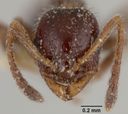Leptothorax
Leptothorax
Classification
- Phylum: Arthropoda
- Subphylum: Hexapoda
- Class: Insecta
- Order: Hymenoptera
- Superfamily: Formicoidea
- Family: Formicidae
- Subfamily: Myrmicinae
- Tribe: Crematogastrini
- Genus: Leptothorax
Pronunciation
How to pronounce Leptothorax: /ˌlɛptoʊˈθoʊræks/
These audio files are automatically generated. While they are not always 100% accurate, they are a good starting point.
Images






Summary
Leptothorax is a genus of small ants largely distributed in the Holarctic region, characterized by their dependency on other ant species for part of their life cycle through social parasitism.
Physical Characteristics
Leptothorax ants are small in size with a slender build. They often exhibit a brown to yellowish coloration, and some species may have a shiny appearance due to the surface structure of their exoskeletons.
Identification Tips
Identification of Leptothorax species can be complex due to the small size and similar morphology of some species. Key features to look for include the shape of the head, body proportions, and the structure of the antennae, which typically have 12 segments without a distinct club.
Habitat
Leptothorax species are commonly found in a variety of habitats, including forests, grasslands, and urban areas. They often nest in soil, under stones, or in rotten wood.
Distribution
This genus is found primarily in Holarctic regions, which includes parts of North America, Europe, and Asia.
Diet
Leptothorax ants primarily feed on sugary substances such as nectar and honeydew secreted by aphids. They also forage for small insects and organic materials.
Life Cycle
Leptothorax has a complex life cycle that includes stages such as egg, larva, pupa, and adult. The life cycle duration can vary by species and environmental conditions.
Reproduction
These ants exhibit a variety of reproductive strategies including normal sexual reproduction and social parasitism, where they rely on the worker ants of other species to rear their young.
Predators
Natural predators include various birds, larger insects, and mammals that forage for small insects.
Ecosystem Role
Leptothorax ants play a role in soil aeration and nutrient cycling as well as serving as prey for other animals in their ecosystem.
Collecting Methods
- Pitfall traps
- Hand collection
- Berlese funnels
Preservation Methods
- Ethanol
- Pinning
- Drying
Evolution
The genus Leptothorax is believed to have evolved through adaptation to ecological niches where social parasitism enhances survival and reproductive success.
Similar Taxa
- Cardiocondyla
- Stereomyrmex
- Romblonella
Misconceptions
Some people may confuse Leptothorax ants with other similar small ant species, leading to misinformation about their behavior and ecological role.
Tags
- Holarctic
- Social Parasitism
- Ants
- Insects